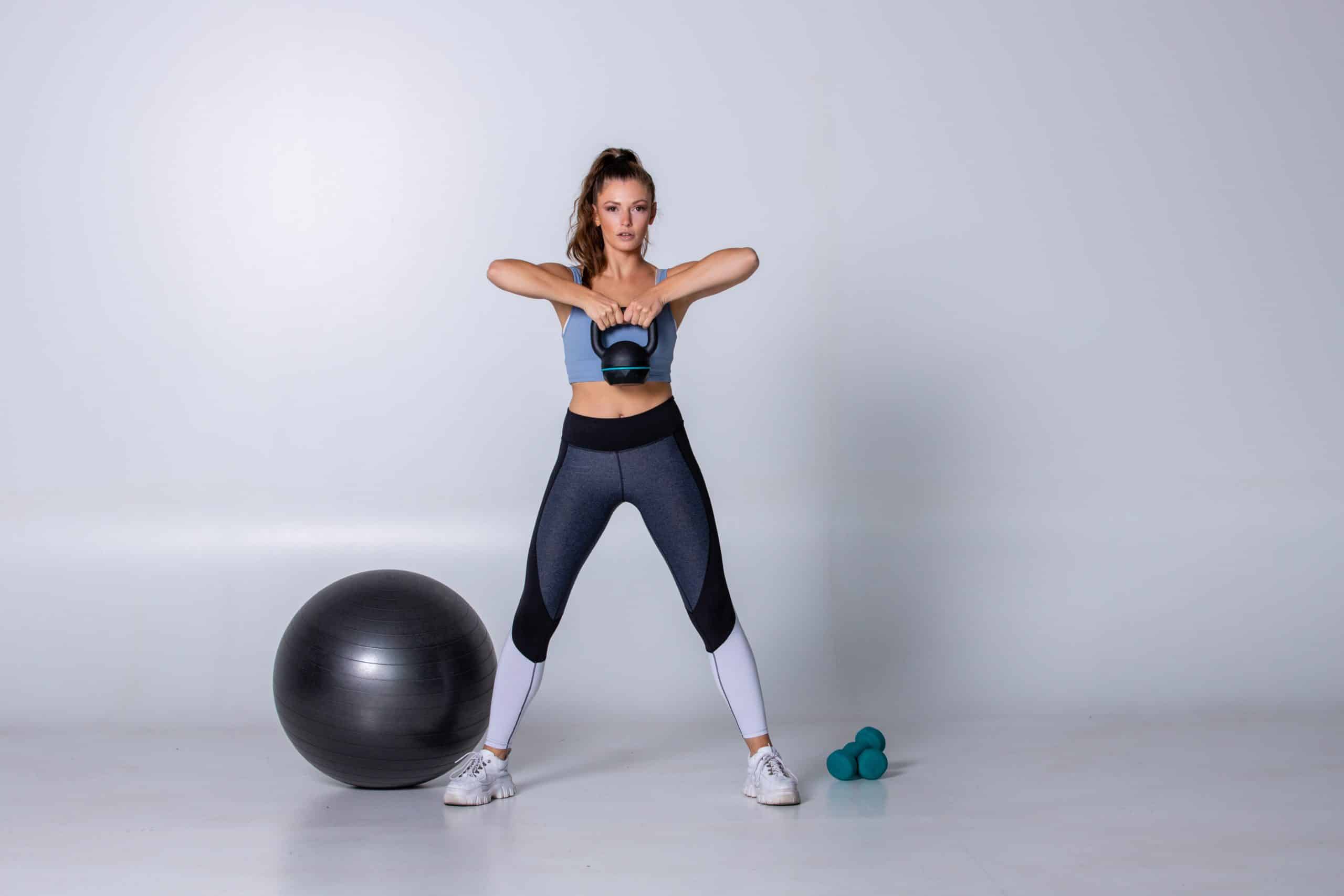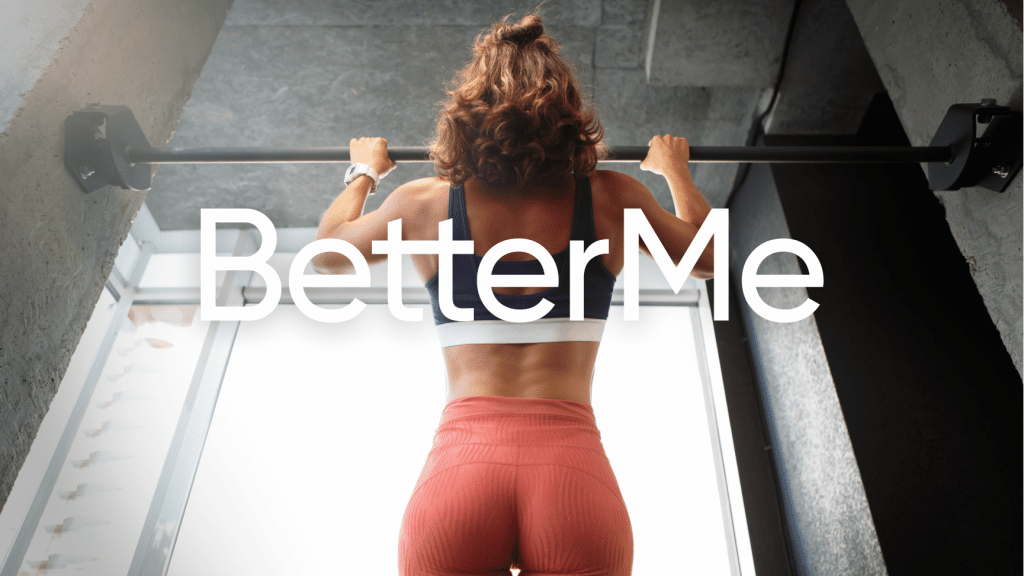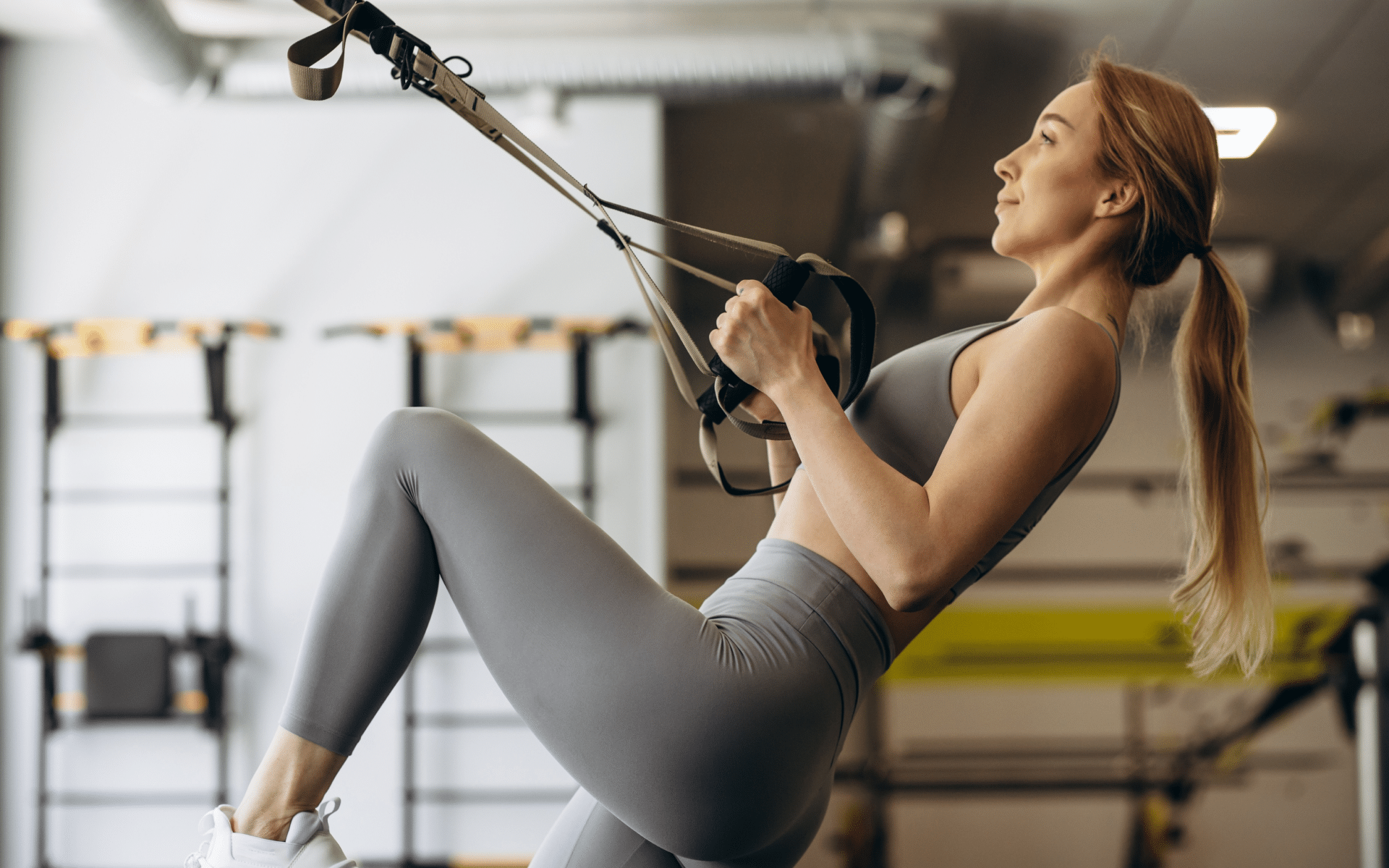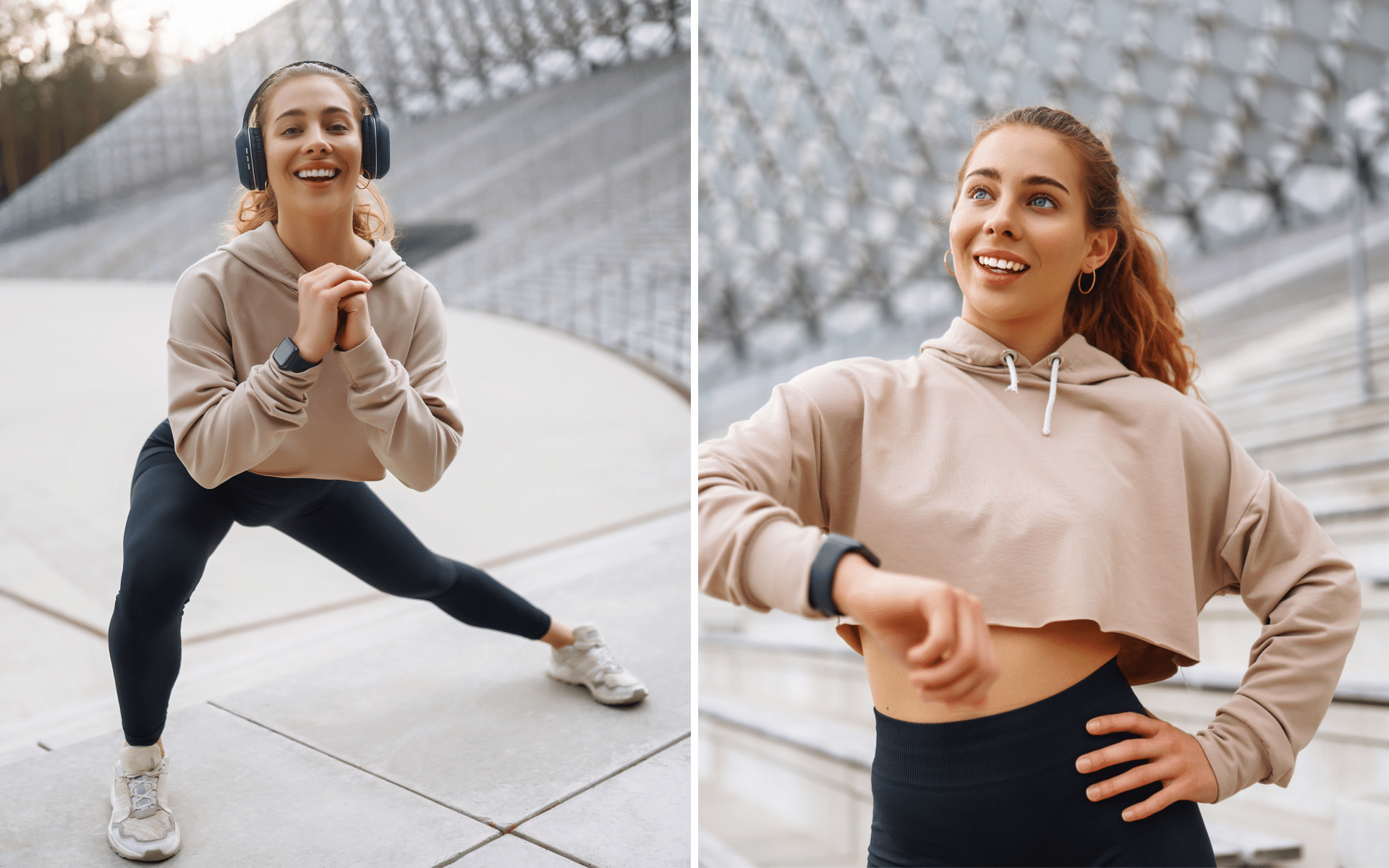A strong core is a foundation for a strong body. The core muscles – including the abdominal muscles, obliques, lower back, and hips –support the spine and pelvis and enable us to move our limbs (8). A strong and stable core helps us maintain good posture and alignment, prevents injuries, and allows us to move our bodies more efficiently. Sit-ups and crunches are often thought of as the best exercises for core strength, but they can put unnecessary strain on the spine and can lead to lower back pain (3). On the other hand, standing exercises are a better way to target the core muscles while protecting the spine. In this article, we’ll discuss everything you need to know about standing core exercises, including their benefits, how to do them, and some of the best exercises to try.
Are Standing Core Exercises Effective?
To understand why standing core exercises are so effective, it’s important to know a little bit about the anatomy of the core muscles.
The core muscles are made up of the transverse abdominis, rectus abdominis, internal and external obliques, and erector spinae. These muscles work together to stabilize the spine and pelvis and allow the trunk to move freely (4).
The transverse abdominis is the deepest layer of abdominal muscle and wraps around the spine like a corset. The rectus abdominis is the “six-pack” muscle that runs down the front of the abdomen. The internal and external obliques are the muscles that run along the sides of the abdomen. The erector spinae is a group of muscles that runs along the spine (2).
When these muscles work together correctly, they provide a stable platform for the spine and pelvis, which allows the trunk to move freely. However, if one or more of these muscles is weak, it can lead to pain and injury.
Standing core exercises engage all of the core muscles, which helps ensure that they are all working together correctly. This can help prevent pain and injury, as well as improve posture and balance (5).
In addition to being effective at strengthening the core muscles, standing core exercises also have the added benefit of being low-impact. This means they are easy on the joints and gentle on the back, which is ideal for those suffering from chronic back pain.
Women who are pregnant or have recently given birth can also benefit from standing core exercises. Exercises help strengthen the muscles that support the spine and pelvis, which can improve posture and help prevent pain during pregnancy and after childbirth (10).
Diastasis Recti is a condition that can occur during or after pregnancy, and it occurs when the abdominal muscles separate. This separation can cause pain and difficulty with activities such as coughing, sneezing, and even laughing (7).
Standing core exercises can help close the gap between the abdominal muscles and improve the function of the core muscles. Hence, it can help reduce pain and improve the appearance of the abdomen (6) (9).
Other types of exercises, such as sit-ups and crunches, can make Diastasis Recti worse (11).
Finally, standing core exercises can be done anywhere, at any time. They don’t require any special equipment or a gym membership, so they can be done at home, at work, or even on a vacation.
Read More: The Best Ab Workouts For Women: Strengthen Your Core And Get The Midriff Of Your Dreams
The Best Standing Core Exercises: No Equipment!
The following exercises are some of the best standing core exercises for strength, stability, and function. Do them regularly to improve your posture, balance, and core strength.
Start with your body weight and progress to using dumbbells or a resistance band when the exercise becomes too easy.
Standing Bird Dog
The bird dog is a yoga pose that is also an excellent standing core exercise. It strengthens the muscles along the spine and pelvis and helps improve posture and balance.
To do the Standing Bird Dog:
- Stand with your feet together and your arms down at your sides.
- Engage your core muscles and lift your right arm and left leg up, keeping your back and pelvis level. Your thigh should be parallel to the ground, and your fingers should be pointing up toward the sky.
- Hold for 5 seconds, and then lower your arm and leg. Repeat on the other side.
- Do 10 repetitions on each side.
Squat With Overhead Press
The squat with overhead press is a compound exercise that works the entire body, including the core muscles. It also helps improve balance, stability, and posture.
To do the Squat With Overhead Press:
- Stand with your feet shoulder-width apart and your arms down at your sides.
- Engage your core muscles and bend your knees to lower into a squat.
- As you squat, press your arms overhead.
- Stand back up, and then lower your arms back down to your sides.
- Do 10 repetitions.
Single-Leg Deadlift
The single-leg deadlift is an excellent exercise for balance and stability. It also works the muscles along the spine and pelvis, which can help improve posture.
To do the Single-Leg Deadlift:
- Stand with your feet together and your arms down at your sides.
- Engage your core muscles and lift your right leg behind you.
- Bend forward at the hips and lower your torso until it is parallel to the ground. Your left leg should be straight, while your right leg should be extended behind you with your heel pointing toward the ground.
- Stand back up and repeat on the other side.
- Do 10 repetitions on each side.
Lunge With A Twist
The lunge with a twist is an effective exercise that works the entire body, including the core muscles. It helps improve balance, stability, and posture as well.
To do the Lunge With A Twist:
- Stand with your feet together and your arms down at your sides.
- Step forward with your right leg and lower your body into a lunge.
- As you lunge, twist your torso to the right.
- Stand back up and repeat on the other side.
- Do 10 repetitions on each side.
BetterMe app will provide you with a host of fat-frying fitness routines that’ll scare the extra pounds away and turn your body into a masterpiece! Get your life moving in the right direction with BetterMe!
Wood Chop
This full-body exercise works the muscles of the arms, shoulders, legs, and core. Moreover, it helps improve balance, stability, and posture as well.
To do the Wood Chop:
- Stand with your feet shoulder-width apart and your arms down at your sides.
- Engage your core muscles and bend your knees to lower into a squat.
- As you squat, twist your torso to the right and reach your arms up overhead as if you were chopping wood.
- Stand back up and repeat on the other side.
Wide Side Crunch
The wide side crunch is an effective exercise that works the muscles of the sides and back of the waist. Other than that, it also helps improve balance, stability, and posture.
To do the Wide Side Crunch:
- Stand with your feet together and your arms down at your sides.
- Step out to the right with your right foot, and then lower your body into a half squat. Your thighs should be parallel to the ground, and your right arm should be extended out to the side for balance.
- Engage your core muscles and bend your torso to the right, feeling a stretch along the left side of your waist.
- Exhale and return to starting position before repeating on the other side.
- Do 10 repetitions on each side.
Knee Tuck Extension
This exercise works the muscles of the back and sides of the waist, as well as the muscles of the arms and legs. It also helps improve balance, stability, and posture.
To do the Knee Tuck Extensions:
- Stand with your feet shoulder-width apart and your arms down at your sides.
- Engage your core muscles and bend your torso to the right while bringing your right knee up to meet your right elbow.
- Return to the starting position and repeat on the other side.
- Do 10 repetitions on each side.
Standing Bicycle Crunches
This exercise works the abs muscles, including the rectus abdominis and obliques. Like the other exercises, it also helps improve balance, stability, and posture.
To do Standing Bicycle Crunches:
- Stand with your feet hip-width apart and your arms down at your sides.
- Engage your core muscles and bring your right knee to touch your left elbow in front of your body. That’s one repetition.
- Alternate sides and continue for 10 repetitions on each side.
Read More: Standing Core Workout: Why You Should Ditch Crunches For These 15 Exercises
Standing Marches
Normally done with a kettlebell or dumbbell in each hand, this march variation strengthens the shoulders as well as the muscles of the core. The bodyweight version will work your arms a bit less but still gives a great challenge to the core.
To do standing marches:
- Stand with your feet hip-width apart and your arms down at your sides.
- Engage your core muscles and raise your right knee to hip height in front of you. Feel the muscles of your abs and obliques contracting to stabilize your body.
- Lower your right leg and raise your left knee to hip height.
- Continue alternating sides for 30 seconds.
Core Stabilizer
This exercise works the abs muscles, including the rectus abdominis and obliques. It helps improve balance, stability, and posture as well.
To do the Core Stabilizer:
- Stand with your feet hip-width apart and your arms straight out in front of your chest, palms touching.
- Engage your core muscles and rotate your torso to the right, then back to the center.
- Alternate sides and rotate your torso to the left, then back to the center.
- Continue alternating sides for 10 repetitions on each side.
Common Mistakes To Watch Out For When Performing Standing Core Exercises
Avoid these common mistakes when performing any of the standing core exercises above:
Not Engaging Your Core Muscles
Performing any of these exercises without engaging your core muscles will not only make the exercise less effective but can also lead to injury.
Think of the muscle-mind connection – if you don’t think about engaging your core muscles, they won’t work as hard. Make sure to focus on contracting your abs throughout the entire exercise.
Holding Your Breath
Many confuse core engagement with holding their breath, but the two are quite different.
When you hold your breath, it increases intra-abdominal pressure, which can lead to several issues including hernias, high blood pressure, and incontinence (1). Instead of holding your breath, make sure to breathe regularly and deeply throughout the exercise.
Betterme will keep you laser-focused on your weight loss journey! Nutrient-packed meal plans, fat-blasting workouts, galvanizing challenges and much more. Try using the app and see for yourself!
Moving Too Quickly Or Using Momentum
When performing any of these exercises, it is important to move slowly and with control. Do not use momentum to swing your arms or legs, as this can lead to injury. Focus on using the muscles of your abs and obliques to stabilize your body and control the movement.
Not Keeping Your Back Straight
It is important to keep your back straight when performing any of these exercises, as rounding your back can lead to lower back pain. If you find that you are rounding your back, focus on engaging your core muscles and tucking your pelvis under to stabilize your spine.
Not Maintaining Good Posture
It’s important to maintain good posture throughout the exercise, even when you’re not moving. Remember to keep your shoulders down and back, your chest up, and your chin tucked. This will help to prevent lower back pain and injury.
Lifting Your Heels
When performing any of these exercises, be sure to keep your heels down. Lifting your heels puts unnecessary stress on your lower back and can lead to injury.
Not Warming Up
Just because these exercises are done standing doesn’t mean they don’t require a warm-up. You’re using your body weight, which makes it even more vital to warm up before you start.
A good warm-up will increase your heart rate, loosen up your muscles, and prepare your body for the exercise to come (12).
Here is a quick and easy warm-up routine you can do before any of the standing core exercises:
- Jog in place for 1 minute
- Do 10 jumping jacks
- Do 10 bodyweight squats
- Do 10 push-ups
- Stretch your arms, legs, and back for 1 minute
The Bottom Line
Standing core exercises are a great way to engage your abs, obliques, and other core muscles. They can help to improve balance and stability, and can also be done anywhere, anytime.
Just be sure to avoid common mistakes such as not engaging your core muscles or using momentum to swing your arms or legs. With proper form and technique, these exercises can help to build a strong and stable core.
Get your personalized
meal plan!
DISCLAIMER:
This article is intended for general informational purposes only and does not serve to address individual circumstances. It is not a substitute for professional advice or help and should not be relied on for making any kind of decision-making. Any action taken as a direct or indirect result of the information in this article is entirely at your own risk and is your sole responsibility.
BetterMe, its content staff, and its medical advisors accept no responsibility for inaccuracies, errors, misstatements, inconsistencies, or omissions and specifically disclaim any liability, loss or risk, personal, professional or otherwise, which may be incurred as a consequence, directly or indirectly, of the use and/or application of any content.
You should always seek the advice of your physician or other qualified health provider with any questions you may have regarding a medical condition or your specific situation. Never disregard professional medical advice or delay seeking it because of BetterMe content. If you suspect or think you may have a medical emergency, call your doctor.
SOURCES:
- Abdominal Pressure – an overview | ScienceDirect Topics (n.d., sciencedirect.com)
- Anatomy, Abdomen and Pelvis, Abdominal Wall (2021, ncbi.nlm.nih.gov)
- Are Sit Ups Bad for You? The U.S. Military Seems to Think So… (2022, issaonline.com)
- Core Muscle Activity during Physical Fitness Exercises: A Systematic Review (2020, mdpi.com)
- Core Stability Training for Injury Prevention (2013, ncbi.nlm.nih.gov)
- Diastasis recti abdominis – a review of treatment methods (pubmed.ncbi.nlm.nih.gov)
- Diastasis recti abdominis during pregnancy and 12 months after childbirth: prevalence, risk factors and report of lumbopelvic pain (2016, ncbi.nlm.nih.gov)
- Effects of core strength training on core stability (2018, ncbi.nlm.nih.gov)
- Efficacy of deep core stability exercise program in postpartum women with diastasis recti abdominis: a randomised controlled trial (2019, ncbi.nlm.nih.gov)
- Exercise During the Childbearing Year (2000, ncbi.nlm.nih.gov)
- Postpartum Pooch – Why Sit-ups Aren’t Cutting It (2017, issaonline.com)
- Warming-up and stretching for improved physical performance and prevention of sports-related injuries (1985, pubmed.ncbi.nlm.nih.gov)















